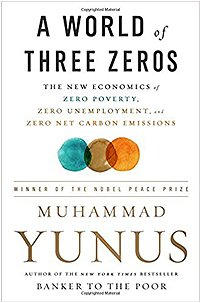More poverty action labs needed
Last Spring, I co-taught a multi-disciplinary course with my wife, a social worker, at the Bridgewater State University on the socio-economics of Bangladesh. One of the topics we covered was "Poverty and Measures to Remove Poverty," and we proudly mentioned Grameen, Brac, and Banchte Shekha, and the tireless work being done by other NGOs.
 However, the students gave a standing ovation when we projected the likeness of Prof. Yunus on the big screen, and shared with them his vow to eradicate poverty from the face of the earth, particularly his famous statement: "I have set a date of 2030 when not a single person in Bangladesh will be poor. Then we will build a poverty museum to show it to our children."
However, the students gave a standing ovation when we projected the likeness of Prof. Yunus on the big screen, and shared with them his vow to eradicate poverty from the face of the earth, particularly his famous statement: "I have set a date of 2030 when not a single person in Bangladesh will be poor. Then we will build a poverty museum to show it to our children."
Towards the end of our discussion on anti-poverty measures, a graduate student asked: "How do you know that the steps taken by the government or an NGO to combat really work? For example, if you offer free childcare to the slum dwellers, does that lower the poverty rate in this group?"
To answer this type of question and to allow better targeting of resources work is being done at the Jameel Poverty Action Lab (J-PAL) of MIT. The J-PAL team believes that when policymakers in developing countries are faced with competing theories and a multitude of tools for poverty reduction, they need clear guidance to rate these and to channel their limited resources. Is it more cost-effective to offer lower interest on loans, or is it better to have interest rates tied to repayment history?
To assess the validity of these competing options, poverty activists, including J-PAL, advocate use of some time-tested methods prevalent in the area of medicine and science: controlled experiments. In some of the their controlled experiments carried out in India, Bangladesh, and Zambia, two otherwise identical groups of people are studied, with one group receiving rewards to keep children in school while the other is not given any such incentive, for example. The results of these controlled experiments show whether one type of reward works better than another, and why.I first heard of the Poverty Action Lab fortuitously, courtesy of Prof. Yunus. A few years ago, we had organised a reception for Prof. Yunus during his trip to Cambridge, Massachusetts to deliver the commencement speech at MIT. J-PAL was then a relatively unknown entity, although not its founders, Esther Duflo and Abhijet Banerjee. I knew of Duflo, who received American Economic Association's prestigious J.B. Clark Award in 2010, because of her work in experimental economics, and tireless application of its techniques in the field of development economics. Banerjee and Duflo have expanded on these ideas in their recently published book, "Poverty Economics."
The most remarkable characteristic of Duflo and Banerjee's theory and practice of economics and the source of its global appeal is its core belief that since resources for poverty reduction are very limited, policy makers must be handed down programmes to implement only if they are known to work.
It is based on very simple logic, which runs as follows: Poor countries are resource poor and have limited budget for poverty-reduction projects. Since they can't waste money, they need only investments which have a high and guaranteed return of investment (ROI). Even if it is time consuming, poverty reduction actions must be given the same scrutiny as any medications. Only those that are found to work using randomised designs ought to be embraced.
For example, if an economist shows that, theoretically, providing free inputs to the farmers should increase their per capita yield, then before the country allocates and spends its scarce resources to provide these subsidies to farmers, there is a need to test the hypothesis under controlled conditions. If not, the policy might result in failure and worse, be thrown out and tarred for the wrong reasons.
Similarly, if free mosquito nets are offered to rural households to combat malaria, there has to be compelling evidence that providing free mosquito nets is the most cost-effective way to eradicate malaria. That's also important because there are competing uses of money allocated for administering the "free net" programme, and a number of possible conditions that need to be ensured to guarantee its success.
Duflo and Banerjee's book also brings forth two related issues: accountability in policy design and the cost-effectiveness of small-scale projects. In the world development market, lenders and borrowers are mostly on the lookout for big projects, e.g., billion dollar World Bank projects for building underpass/overpass to solve traffic problems, or to cut carbon emissions and mitigate the effects of global warming. Proponents of poverty economics suggest we redouble our efforts to look for and find the low-cost options, "unpicked low-hanging fruits," ones that are ripe and just need to be plucked.
The low-hanging fruit is used as a metaphor in many policy textbooks and discussions to refer to actions that cost little but pay much. These are the fruits that are hanging from the tree and can be reached without climbing the tree or bringing in the ladder. To generalise, these are "easily obtained gains; what can be obtained by readily available means."
An example from environmental policy that immediately jumps to my mind is that of regulating cigarette smoking. It is now accepted that tobacco smoking results in various health and other hazards, not only for the smoker but also for others. However, once you accept the fact, and attempt to restrict cigarette consumption, the instruments that were used in the past were banning smoking and restricting production of cigarettes. However, a complete ban leads to bootlegging and often the cost of enforcement is heavy.
On the other hand, if you impose a tax on cigarettes to reflect the health costs of smoking, the government collects and the smoker has the freedom to decide whether to continue smoking. The tax can be collected at the source, i.e. from the tobacco company or at the retail level or both, as is currently being done in the US. Of course, additional measures are needed to address other issues, e.g., sale to minors and misleading advertisements.
There is a similar case of "low-hanging fruit" in the policies to address global warming. Once it is established that global warming is principally caused by emission of CO2 into the atmosphere, then restriction of CO2 emission can be achieved in many ways. A country could ban coal-powered electric plants, but that might impractical. Other CO2 reduction measures, including imposition of a carbon tax or clean air laws to regulate coal-powered plants, have run into fierce opposition in many countries.
Electricity is considered one of the basic ingredients of life, akin to air, and any attempt to raise its price meets with fierce resistance at the public forums, and the various regulatory and legislative hearings in the US, for example. But there is a low-hanging fruit in this policy area too, and involves charging higher rates for high consumption levels. It is well-known that the cost of power generation exhibits increasing costs.
The remedy is a two-or multi-tiered pricing structure: rural or low-use urban households pay at a lower rate whereas the high-end users pay at a higher rate to reflect the marginal cost. While this concept is known as "price discrimination" in the standard text books, it is not really a bad form of discrimination. Small consumers pay less, large consumers pay more. Not as bad as the normal form of discrimination where sometimes larger consumer pays less. For example, commercial banks charge more to small borrowers!
Returning to poverty economics, a few questions still remain to be answered. If the low-hanging fruits are waiting to be plucked, how come they have not been plucked yet? Duflo's research shows that many low hanging fruits are not always paid attention to because they are within easy reach. Easily available gains are often considered inferior. Again, this theory is currently being tested in experiments. But, we are familiar with this sentiment since it resonates of Tagore's famous line: "Dekha hoi nai chokkhu melia... ekti dhaner shisher upor ekti shishir bindu." Alas, I missed the dew drops on the ears of rice.
The writer lives and works in Boston.
Source:Â http://www.thedailystar.net/newDesign/news-details.php?nid=189868


